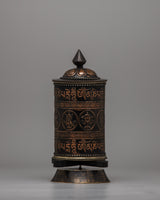
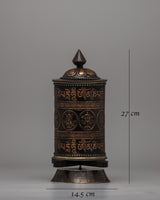
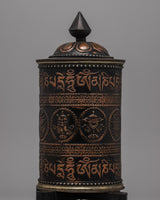
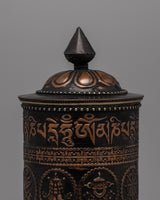
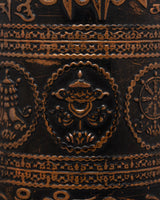
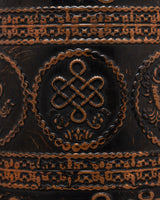
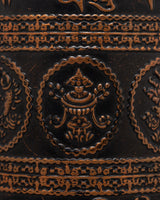
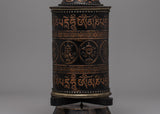
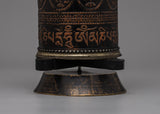
Hand Spinning Prayer Wheel | Channeling Spiritual Energy Through Devotional Practice

100% AUTHENTIC

HANDMADE

FREE SHIPPING
Hand Spinning Prayer Wheel
About our Prayer Wheel
Crafted with meticulous attention to detail and care upon a foundation of copper and brass, the Hand Spinning Prayer Wheel is a representation of the essence of Tibetan spirituality. At 27cm in height, it is a physical manifestation of devotion, with mantras and auspicious symbols deftly engraved on its wheel. Practitioners perform a sacred rite in which they spin a wheel to represent the constant flow of blessings and positive energy into the globe.
This prayer wheel, which was meticulously created by hand with great attention to detail, is not only aesthetically pleasing but also deeply spiritual. It is said that every turn of the wheel will call forth blessings, wash away bad luck, and promote harmony and inner serenity. The Hand Spinning Prayer Wheel is a powerful reminder of the universal wisdom of Buddhist teachings and the interconnection of all beings, whether it is employed in one's own meditation practice or shown in hallowed places.
Introduction to Prayer Wheel
A prayer wheel is cylindrical on a spindle used in Tibetan Buddhism. It is typically inscribed with the mantra "Om Mani Padme Hum" and rotated by hand as a form of spiritual practice and to accumulate merit. Spinning the wheel is believed to have the same spiritual benefits as verbally reciting the mantra. The use of prayer wheels is widespread in Tibetan Buddhism and has spread to other cultures.
--------------------------------------------------------
Size: 27 cm(Height) x 14.5 cm(width)
Weight: 0.534 kg
Material: Copper, Brass
--------------------------------------------------------
How does the Buddhist Prayer Wheel benefit us?
The benefits associated with rotating the wheel are numerous. It promotes knowledge, compassion, and bodhicitta in the practitioner and improves siddhis (spiritual powers such as clairvoyance, precognition, etc.). The practitioner can repeat the mantra as often as possible while the wheel is rolling, maintaining a calm, meditative attitude. A Tibetan Buddhist tradition holds that at the completion of a practice session, one should dedicate any acquired merits to the benefit of all sentient beings. Then three times Om Ah Hum. This is usually among Tibetans after finishing any Buddhist practice, including the prayer wheel exercise.
Why choose Evamratna?
To give your space a peaceful, powerful, and attractive feel, we are introducing Buddhism-inspired home décor items to enliven your space with zen vibes, in the form of decoration, an art form, or inspiration.



















